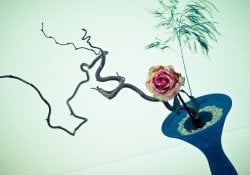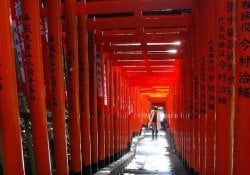Bonsai [盆栽] is a Japanese art form that produces miniature trees. Its name literally means "tree in a tray" or "tree in a pot". In this article, we are going to talk a little about this Japanese art of growing miniature trees.
Bonsai trees are not genetically small, they are small because of their container, restriction of root growth and because of grafting. It also receives less fertilizer and nitrogen, and is watered moderately.
A bonsai needs to have other attributes than just being in a shallow pot. The plant must be a replica of a miniature nature tree. This art is also cultivated by other cultures such as Chinese Penzai or viathnemite Hon Non Bo.
It should simulate the growth patterns and effects of gravity on the branches, in addition to the time marks and general structure of the branches. Essentially it is a work of art produced by man through expert care.
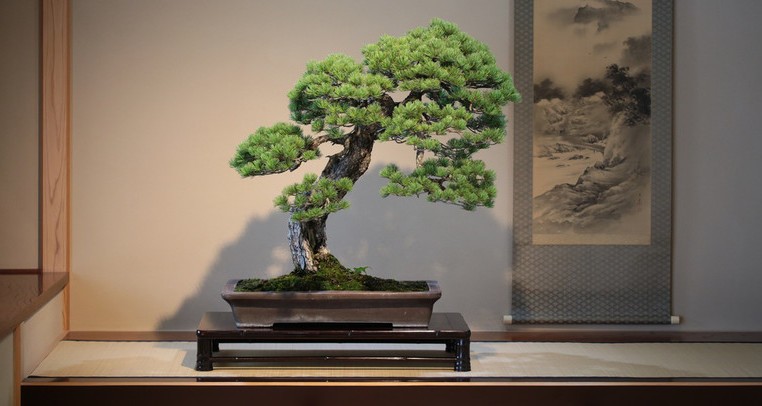
Índice de Conteúdo
What is the purpose of Bonsai?
The purposes of bonsai are primarily contemplation for the viewer and the pleasant exercise of effort and ingenuity for the cultivator.
In contrast to other plant growing practices, bonsai is not intended for the production of food or medicine. Instead, bonsai practice focuses on long-term cultivation and the formation of one or more small trees in a pot.
The practice of bonsai is sometimes confused with dwarfism, but dwarfism usually refers to the research, discovery, or breeding of plants that are permanent genetic miniatures of existing species.
Plant dwarfism often uses selective breeding or genetic engineering to create dwarf cultivars. Bonsai does not require genetically dwarf trees, but relies on growing small trees with regular stock and seeds.
Bonsai uses cultivation techniques such as pruning, root reduction, potting, defoliation and grafting to produce small trees that mimic the shape and style of full-size, mature trees.
What is the origin of Bonsai?
This art has been practiced for over 1000 years and is associated with a broad set of rituals, techniques and terms. Despite the strong association between bonsai cultivation and Japanese culture, it was actually the Chinese who were the first to grow trees and shrubs in ceramic pots.
There is evidence that, as early as 200 AD, the Chinese were growing potted plants (better known as Penjing) as part of their gardening routine. The word Bonsai came from Chinese Penzai.
The Japanese art of bonsai originated from Chinese practice starting in the 6th century, imperial embassy officials and Buddhist students from Japan visited and returned from mainland China. They brought back many Chinese ideas and goods, including container plants.
Over time, these container plantations began to appear in Japanese writing and representational art. In the medieval period, recognizable bonsai were depicted in hand scroll paintings such as the Ippen shonin eden (1299).
A close relationship between Japan's Zen Buddhism and potted trees began to shape bonsai's reputation and aesthetic. During this period, Chinese Buddhist monks taught in monasteries in Japan.
One of the monks' activities was to present to political leaders various miniature landscape arts as admirable achievements for men of taste and knowledge. Arrangements from this period included miniature figures in the Chinese fashion.
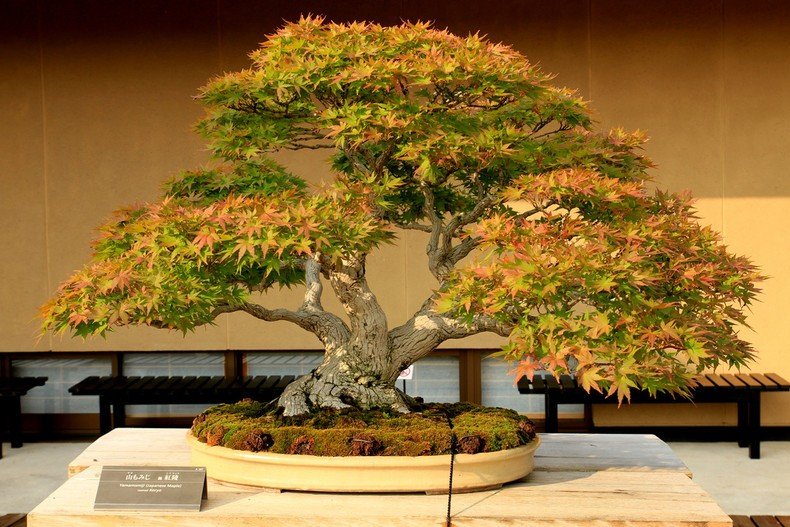
The history of Bonsai in Japan
Japanese artists eventually adopted a simpler style for bonsai, increasing the focus on the tree by removing miniatures and other decorations and using smaller, simpler pots. A long history of Bonsai began in Japan.
By the 14th century, the term for dwarf potted trees was Hachi no Ki [鉢の木] which literally means tree in the bowl. By the end of the 18th century, bonsai cultivation in Japan was spreading and began to interest the general public.
One of the oldest known bonsai trees, considered one of Japan's national treasures, can be seen in the collection of the Tokyo Imperial Palace. It is a 500-year-old five-needle pine tree called Sandai-Shogun-no-Matsu.
In Japan after the 1800s, bonsai began to shift from being the esoteric practice of a few experts to becoming a widely popular art form and hobby. Scholars gathered in the early 19th century to discuss recent styles in Bonsai art.
The Japanese version of potted trees, which was previously called hachiue or other terms, was renamed bonsai in the 19th century. It took nearly a century for this name to spread in Japan and spread to the West.
After World War II, various trends made the Japanese tradition of bonsai increasingly accessible to Western and worldwide audiences. An important trend has been the increase in the number, scope and prominence of bonsai exhibits.
Several world events and conventions began to appear, gaining space and appreciation from the western public. A third trend has been the increasing availability of specialist bonsai training, followed by specialist stock of plants and components.
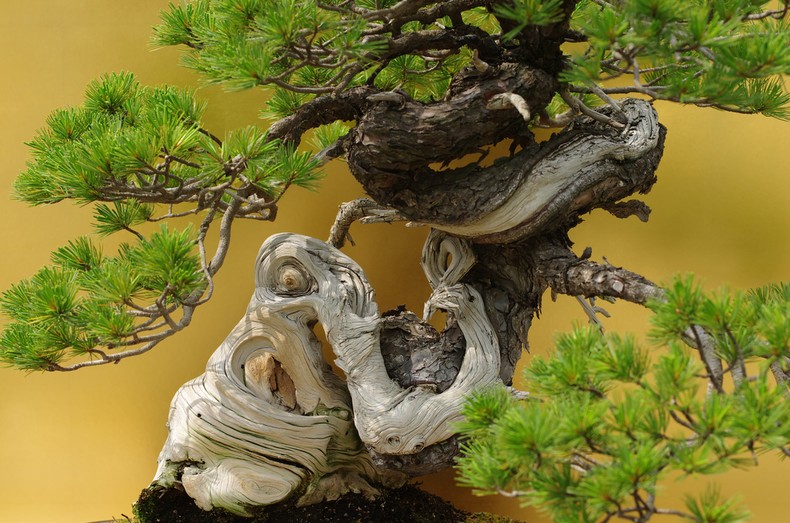
The article is still halfway through, but we recommend also reading:
How to grow a Bonsai?
A bonsai is created starting with a sample of source material. It can be a cutting, seedling or small tree of a species suitable for bonsai development. To grow a Bonsai, there are 3 known practices:
- Misho - Grown from seed;
- Yamadori - Grown from seedlings;
- Alporque – Method of asexual reproduction of plants that causes the appearance of adventitious roots;
Bonsai can be created from almost any evergreen species of woody trunk trees or shrubs that produce true branches and can be grown to remain small through confinement in pots with crown and root pruning.
Some species are popular as bonsai because they have features, such as small leaves or needles, that make them suitable for the bonsai's compact visual scope.
The source sample is modeled to be relatively small and to meet bonsai aesthetic standards. When the candidate bonsai approaches the final planned size, it is planted in a display pot.
From that moment on, its growth is restricted by the vase environment. Throughout the year, the bonsai is shaped to limit growth, redistribute leaf vigor to areas that require further development, and meet the artist's detailed design.
Bonsai care
A bonsai must always be pruned for the renewal of branches, and a rejuvenation. Problems, badly positioned or dead branches are removed, and less healthy leaf areas are removed.
Pruning is fundamental for bonsai, a basic structure is established, problems are avoided, the energies (force) of growth are balanced or diverted.
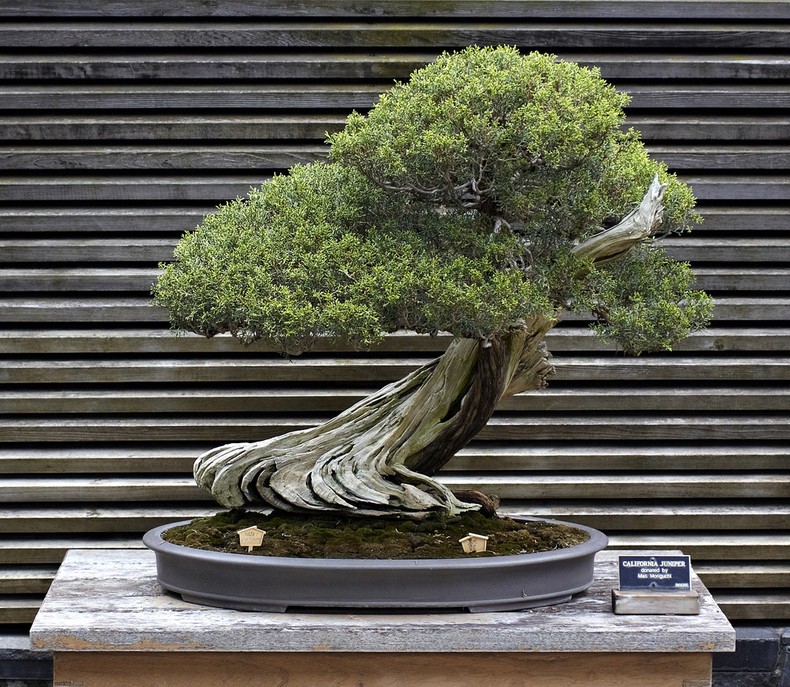
Bonsai Types, Sizes and Styles
Bonsai can be separated by styles, tree types and sizes. Below we will show the most common styles and sizes.
Bonsai sizes
Japanese bonsai exhibits and catalogs often refer to the size of individual bonsai specimens. There are a number of specific techniques and styles associated with certain sizes.
Responsive Table: Scroll the table sideways with your finger >>
| wide bonsai | ——- | ——- |
| Common name | Classification | tree height |
| Imperial bonsai | eight hands | 152–203 cm (60–80 in) |
| Hachi-uye | six hands | 102–152 cm (40–60 in) |
| Dai | Four hands | 76–122 cm (30–48 in) |
| Omono | Four hands | 76–122 cm (30–48 in) |
| medium bonsai | ——- | ——- |
| Common name | Classification | tree height |
| Chiu | Two hands | 41–91 cm (16–36 in) |
| lead | Two hands | 41–91 cm (16–36 in) |
| Katade-mochi | with one hand | 25–46 cm (10–18 in) |
| miniature bonsai | ——- | ——- |
| Common name | Classification | tree height |
| Komono | with one hand | 15–25 cm (6–10 in) |
| Shohin | with one hand | 13–20 cm (5–8 in) |
| mom | palm size | 5–15 cm (2–6 in) |
| Shito | finger tip size | 5–10 cm (2–4 in) |
| Keshitsubo | poppy seed size | 3–8 cm (1–3 in) |
Bonsai styles
See below the styles of Bonsai and what they have in common:
- Chokan : Formal upright style;
- Moyogi : Informal upright style;
- Shakan : Leaning style;
- Kengai : Waterfall style;
- Han-kengai : Semi-waterfall style;
- Fukinagashii : Windswept;
- Hokidashi : Broom style;
- Bunjingi : Literary style;
- Takosukuri : Tentacle style;
- Nejikan : Dragon style;
- Bankan : Spiral style;
- Sharimiki : Deadwood style;
- Sabamiki : Deadwood style;
- Sekijoju : Root over stone style;
- Ishisuki : Tree over rock style;
- Neagari : Exposed roots style;
- Soju : Mother and son style;
- Sokan : Double trunk style;
- Tosho : Triple trunk style;
- Kabudashi : Interlocking logs style;
- Netsunagari : Sinuous raft style;
- Ikadabuki : Straight raft style;
- Yose Ue : Forest style;
- Penjing : Miniature landscape style;
Types of Bonsai - Trees
The types of trees used in Bonsai are endless, but we have separated the best known here to make a small list:
- Acer
- Acerola
- Blackberry
- Arrack
- mastic
- Rhododendron
- Bertholletia excelsa
- Bougainvillea
- boxwood
- calistemus
- Carmona (genre)
- Cherry tree
- night's-lady
- Eugenics
- false-rica
- Ficus
- Gabiroba
- Ilex
- Ipê
- Jabuticaba
- Lantana
- Privet
- Apple tree
- Malpighia
- Nandina
- panel
- mulatto dick
- Pistachio
- Pitangueira
- Reseda
- Pomegranate
- Schefflera
- Serissa
- Taxodium
- Ulmus
Bonsai Care Guide
So you want to learn how to take care of Bonsai or even make your own Bonsai completely from scratch? Know that you are on the right path and in the right place for this to happen!
The Bonsai Care Guide – It's a Digital E-BOOK with more than 50 sheets of pure Explanatory Content that will teach you every step by step on how to make your first Bonsai, even if you've never done it before!
In addition, you will also receive 4 more exclusive E-BOOKS as a BONUS that will complement your studies on Bonsai and also teach you how to make money with Bonsai cultivation...
What will you learn?
- BONSAI STORY
- HOW TO ORGANIZE!
- CUP STYLIZATION AND FORMATTING!
- SUITABLE SPECIES!
- HOW TO KEEP IT HEALTHY!
- PESTS AND DISEASES!
- TOOLS YOU WILL NEED!
- MAINTENANCE PRUNING!
- RADICAL PRUNING AND SACRIFICE BRANCH!
- HOW TO MAKE A BONSAI!
- MAINTENANCE PRUNING!
- WHEN AND HOW TO IRRIGATE AND FERTILATE!
HOW TO MAKE BONSAI CROOKED – This Guide Will Guide you how to shape the branches, leaving them crooked in a Natural and Perfect way by the Art of Wire! Wiring is a crucial technique for training and styling Bonsai trees.
TYPES OF FERTILIZERS FOR BONSAI – Here you will find some types of Fertilizers to Strengthen your Bonsai and make it more beautiful. And Valuable Tips!
HOW TO MONETIZE BONSAI GROWING – Cultivating Bonsai is good for physical and mental health. It also draws a lot of attention. In this guide I will teach you how you can monetize your bonsai cultivation and earn extra money.
HOW TO GET STARTED WITH BONSAI – This guide is an Exclusive release, feel privileged to be receiving this completely Free Bonsai Entrepreneurship Guide as a BONUS FROM OUR TO YOU!


